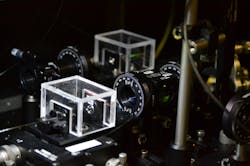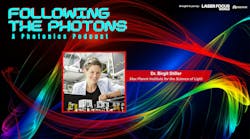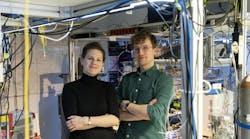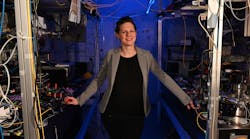Sound waves propagating in one direction break light transmission reciprocity
A team of Max Planck researchers, led by Xinglin Zeng, Philip Russell, and Birgit Stiller, built an optical vortex insulator using sound waves that propagate only in one direction to break the light transmission reciprocity for chosen vortex modes.
This advance significantly boosts the signal quality and purity of optical vortices—signals transmitted in optical communications—and has potential applications in optical systems such as mode-division-multiplexed communications, optical tweezers, vortex lasers, or quantum manipulation systems.
“Information can be encoded in different properties of light, such as the wavelength, in phase and amplitude, but also in polarization and orbital angular momentum (OAM),” says Stiller, who leads the Quantum Optoacoustics Research Group (see Fig. 1). “The latter two can be studied very conveniently in chiral optical fibers. We’re interested in how light with different polarization and orbital angular momentum interacts with sound waves and how this interaction can be leveraged.”
Optical communications of the future
Optical communications can be improved by increasing the amount of optical information transmitted. And this can be accomplished via multiplexed channels, such as using many optical wavelengths, different polarization states, or multiple time slots.
During the past decade, optical spatial modes—eigenfields in the waveguides—were widely exploited to further improve the communication capacity, thanks to little crosstalk between orthogonal spatial modes.
For classical and quantum communications, the use of vortex modes in multiplexing methods is advantageous. This special mode set possesses a helical optical phase distribution, which provides an additional degree of freedom for multiplexing optical signals.
Outmaneuvering reciprocity
When developing their device, the team had to work around a fundamental principle of optics: reciprocity. This requires a symmetrical response of a transmission control channel when the source and observation points are interchanged.
The team’s device is by design nonreciprocal—it’s based on light-sound interactions within a spiral optical fiber to naturally break the reciprocity of the light waves propagating forth and back (see Fig. 2).
The team taps into a nonlinear interaction, Brillouin scattering, which describes light scattering from traveling acoustic waves. “As the sound waves travel in one direction, they naturally enable nonreciprocal behavior,” she says. “We studied this property for OAM modes in optical fibers and it led us to the first nonreciprocal device for OAM modes.”
While OAM research has been ongoing for about three decades, Stiller points out there aren’t many approaches that can achieve nonreciprocal propagation for OAM modes—especially not ones to selectively act on a certain set of fiber modes.
“Research in Brillouin scattering is also quite old, but so far optoacoustic interactions with OAM modes haven’t been studied and used for applications,” she says. “In our work, we combined them and were able to show light-sound interactions for OAM modes and demonstrate a nonreciprocal device acting as an isolator or one-way amplifier.”
The first nonreciprocal system for vortex modes “opens up a new perspective in nonreciprocal optics—the same physical effect can happen not only on the fundamental modes, but also on higher-order modes,” says Zeng, a postdoctoral researcher.
Now, the team is exploring “more exotic sound waves with an unusual structure and we want to study their interaction with light in chiral optical fibers,” says Stiller.
FURTHER READING
X. Zeng et al., Sci. Adv., 8, 42 (2022); doi:10.1126/sciadv.abq6064.
Related Content
About the Author
Sally Cole Johnson
Editor in Chief
Sally Cole Johnson, Laser Focus World’s editor in chief, is a science and technology journalist who specializes in physics and semiconductors.






